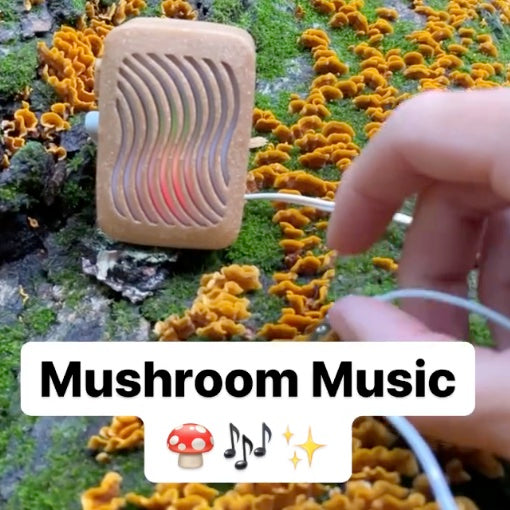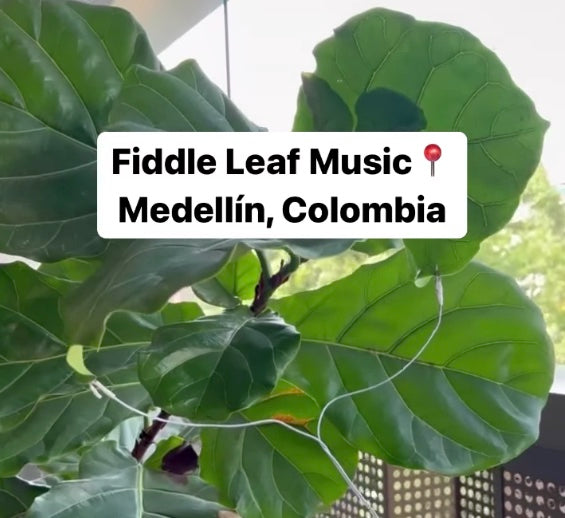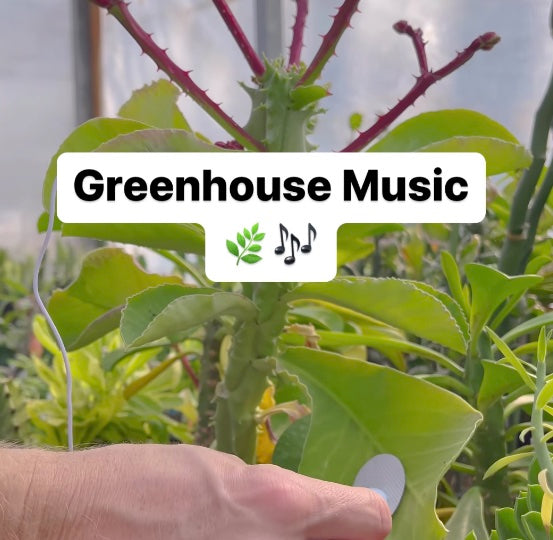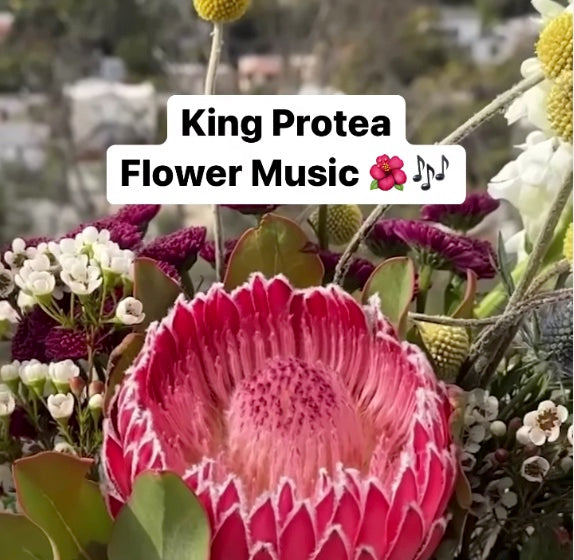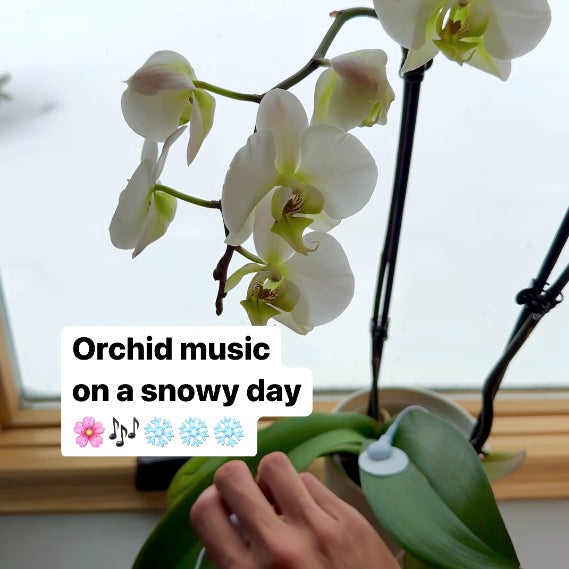Frequently Asked Questions


Most Popular Questions
What exactly is being measured?
PlantWave measures microfluctuations in conductivity between two points on a plant. The amount of conductivity between these two points is largely related to how much water there is between them. That changes as plants photosynthesize and move chloroplasts around.
The variation is graphed over time, which produces a wave. We take that wave and translate it into pitch. Then those pitch messages are routed to control instruments we designed. So, each note you hear is an expression of a change happening within the plant in the moment. The greater the distance between two adjacent notes, the greater change is happening within the plant.
What inspired this idea?
Our inspiration for writing music always came from nature. We used to go out into the woods, record forest sounds and then go back into the studio to listen to the sounds, connect to the feeling of those natural places and write music from there. For us, creating music from plant data was just a natural progression of this practice. Instead of "sampling" the sounds of nature, we started sampling data from nature. Instead of having nature fuel the inspired playing of our instruments, we connected nature directly to the instruments with technology.
Why listen to plants?
The practice of taking time to listen to plants can help take a person out of the busyness of their day. It becomes a ritual where the focus moves away from the "to-dos" and towards harmony with nature. By slowing down to tune into the subtle changes in plant music, we access a state of heightened presence in the moment. Feelings of increased presence are associated with stress reduction, increased creativity, clarity and openness.
Are there proven benefits of listening to plants?
We haven't conducted peer reviewed studies yet. A survey of hundreds of owners of our previous device, MIDI Sprout, showed users feeling more relaxed, connected and inspired after listening to plants. The upgrades we're making with PlantWave will allow us to begin partnering with research institutions to do a more quantitative analysis on the effects of plant music.
More generally, there have been studies done on the effect of stochastic patterns (random, non-linear and non-repeating) on the health of the mammalian brain. If you're trying to envision what that means, just think of laying under a tree where the light from the sun is filtered by leaves and branches blowing in the wind. That phenomena you're experiencing (the seeming randomness of the patterns of light resulting from the tree and sun) is stochastic. In a similar way, plant music is stochastic in that it's taking a set of natural variables and presenting them to you as sound.
Do different plants make different sounds?
While the sounds and instruments were designed by us for plants to play, different plants will produce different patterns, melodies or "songs". In fact, different leaves within the same plant will produce different patterns. Over time, even those patterns will change. Rather than switching from plant to plant, we recommend spending time with a plant and tuning into its shift in patterns over longer periods of time.
In addition to these changes in patterns, there are some instruments in the PlantWave app that will only be triggered when a plant displays an especially high amount of activity. So, you may listen to a plant playing flute all day and then at some point notice that it's added chimes or bells. This is a sign of a significant shift in activity of yor plant.
We should also mention, this experience is something completely unique to PlantWave and is part of the patented sonification technology we've built over the last decade. These moments are also some of the most special listening experiences we've had in our lives, so we're excited to share them with you!
Can you tell what species a plant is by listening to it?
In our experience, no two plants produce exactly the same patterns. In fact, no two leaves within the same plant produce the same patterns. For that reason, reverse engineering what pattern is produced by what plant is close to impossible. We have experienced more dry plants producing less of a signal and more hardy tropical plants producing more of a signal. Beyond that, getting into specific species and plant type is more challenging.
Will the music tell me about the health of my plants?
PlantWave is not meant to be a diagnostic tool for plant health. That said, if you are getting a lot of signal out of a plant one day and the next day it's totally silent, it might be worth checking the soil moisture. If a plant is thirsty, it won't have as much water to produce the fluctuations we're measuring and your plant music will be replaced by silence. Silence doesn't always mean a lack of water, though. Sometimes, it just means a plant is less active. We call this “being chill.”
Are the plants listening to us?
It's unclear. We know that plants do respond to sound, but each plant seems to be tuned to a frequency that most serves its survival. For instance, some trees will grow towards an mp3 player playing the sound of water through a pipe. Some plants will release a toxin in their leaves when they hear another nearby plant being munched on by a caterpillar. So, while we know that plants have the capacity to respond to sound, we don't yet have data supporting them listening to and responding to their own music. We can say with confidence, however, that our plants that are connected to PlantWave seem to be a little extra healthy. Maybe it's the slight current we're sending it. Maybe it's the music or maybe it's the extra attention we give musical plants. The more we play and the more we experiment, the more opportunity we have to learn. We hope PlantWave inspires that curiosity with you.
What are plants responding to?
There are so many things plants respond to. They respond to light, moisture, heat, cold, barometric pressure. Some respond to touch and sound. To know what a plant is responding to in any one moment is like trying to read another person's mind. You might have an idea, but there's a lot more going on that you don't know about. We encourage you to use your time shared with musical plants to allow the responses and shifts in the plants music to be a mirror for your own experience. When you hear a shift in the plant. Tune into that moment. What is shifting within you?
So, you're putting microphones on the plants and you hear flutes?
Not exactly. We are measuring slight fluctuations in the conductivity of the plant with electronic sensors, not microphones. And then we are graphing those fluctuations as waves, translating them into pitch and then sending those pitch messages into software with samples of instruments (like flutes, piano, etc.) So, no, a plant doesn't necessarily sound like a flute, but it can play a flute if given the right tools, specifically a PlantWave.
Is this safe for plants?
Making plant music is safe for any plant that can hold the weight of an electrode. In fact, some of our plants have been connected to our technology for years (broadcasting at Plants FM). Those plants continue to thrive and are some of the happiest plants in our care.
Further, studies have shown that slight electrical stimulation of plants can actually accelerate growth. The amount of electricity we are using with PlantWave is very slight. If you’ve ever touched both connectors on a 9v battery, you probably didn’t feel anything. Maybe if you touched them with your tongue you got some sensation. Well, PlantWave is sending ⅓ that power - just around 3v.
Where's the science behind this?
PlantWave makes use of tools that have been around for more than a century and amplifies their power through digital and mobile technology. The circuitry used in PlantWave is the same as that which is used in a lie detector. It's called a psychogalvanometer and it measures galvanic resistance over time. Lie detectors were first applied to plants by an FBI interrogator, Cleve Backster back in the 1960s. He noticed plants seemed to respond to thoughts and emotions. Russian scientists also did similar experiments with similar results. More recent attempts to replicate the same results with similar experiments have been unsuccessful. That, however, doesn't mean plants aren't responding to people. It just means that there isn't sufficient evidence to support they are beyond a doubt responding to people. Let us not forget absence of evidence does not equal evidence of absence.
It seems clear to us that more data is needed in order to have a better understanding of what is occurring with plants. In our experience and in our user's experience, it seems likely that there's a relationship and a connection happening between plants and humans. With better tools and more data, we look to create opportunities to better understand the reasons behind these phenomena.
Did I see you at...?
Probably. We've been around and we get hired to do a lot of really cool events around the world including TED2019, In Goop Health, Copenhagen Fashion Week, Azulik and Habitas in Tulum, Envision Festival (Costa Rica), SXSW, Lightning in a Bottle, The Philadelphia Museum of Art, The Noguchi Museum, plus events in Bali, Thailand and Chile just to name a few. Also, we had over 1,800 users of our previous device, many of whom performed live or created their own plant music installations. If you've seen plant music, it's a pretty safe bet it was us.
Did I see you in...?
Probably. Our story has been told many times in all sorts of media including ABC News, Good Morning America, NPR, Wired, The Guardian, Hypebae, Vogue, Vice, MTV, Arte TV (DE), TED, The Telegraph, Artforum, NOWNESS and more. Check out thisselection of press links.
Why did you change your name from MIDI Sprout?
MIDI Sprout was originally developed solely for electronic musicians. For this audience, familiar with using MIDI (a language for communicating between computers and synthesizers), MIDI Sprout was a memorable name. As the device started reaching a wider audience, however, the name was less obvious (as evidenced by the number of people who called it "Mini Sprout.")
We chose to re-brand in 2019 to PlantWave to acknowledge the device is more than just a creative tool. PlantWave is a way of connecting to plants through music regardless of whether one is a professional musician or a casual listener. Plant music has gone from an experimental practice to what is now a musical genre gaining greater appeal. Like the many waves of musical movements before it, this genre needs a name, so we're calling it PlantWave.
For more info on the difference between PlantWave MIDI Sprout, see comparing PlantWave and MIDI Sprout
Can I record my plants and listen later?
Yes. With the Plus version of the PlantWave app, you can record music from your PlantWave right from your phone. You can save this for later listening and share it with friends via text or email.
While the free version of the PlantWave app has everything you need to listen to your plants and includes 5 sets of instruments to choose from, the Plus version ($3.99/mo or $34.99 annual) adds features like recording, changing key and more instruments to enjoy. Plus subscribers also benefit from new sets of instruments being added monthly.
Can I use PlantWave music commercially in, my video, my song, commercial space, wellness service or in advertisements?
First, let's get clear on what you mean by PlantWave music. PlantWave can be used in two ways.
- With our app, which has instruments we've built for plants to play.
- As a MIDI controller, allowing a musician to connect a plant to a synthesizer or digital audio workstation (DAW) and create unique music with their own sounds.
In scenario 1, sounds in our app are licensed to our users on a non-commercial basis. This means any commercial use of these sounds requires a separate commercial license. That said, independent artists are permitted to use these sounds publicly with proper credit in independent (non-major label) releases that have less than 1,000,000 total streams across all streaming services. The typical sized yoga, meditation or wellness class is also covered for those who want to share PlantWave music in their healing work, with proper credit to PlantWave. You can read more on how this works in section 1.2.5 of our End User License Agreement. If you're a musician, the easiest way to ensure you have rights to use the sounds in your music is to design your own sounds. Let's jump into that.
In scenario 2, one is using PlantWave as a MIDI controller to play a synth or DAW with their own sounds. In this case, the sounds are owned by the artist. While the MIDI from the PlantWave is being used by this artist, PlantWave makes no claim on the MIDI from the device. Whether or not you're allowed to use that MIDI in your production is a conversation for you and... your plant. So ask nicely. They usually say yes.
Again, if you have any questions related to using PlantWave in your creative project, check out our End User License Agreement. Or, to obtain a commercial license for a professional studio production, contact us.
What's the difference between PlantWave and...?
We're not going to name names, here. We've tried the other plant music devices out there. Simply put. PlantWave sounds better. Other plant music devices create sounds that seem novel at first, but are often quite jarring and not something one would feel good listening to for a long period of time.
PlantWave was created by sound artists, who in 2012, were inspired to make music in partnership with nature. We knew the music resulting from this partnership would be something better than anything we could have created ourselves.
A key part of the art of collaborating with plants is design. Over the past 10 years, our team has designed and patented a system that works with plants to create music that rivals the quality and listening enjoyment of recorded music. In fact, 90% of PlantWave listeners report their time listening to plants is replacing time spent listening to recorded music on other apps. Many listen to music from PlantWave for hours or days on end. Luxury hotels even broadcast PlantWave in their lobbies because they know it creates a relaxing environment.
PlantWave listeners report feeling more relaxed, connected and inspired after listening to plants. But don’t take our word for it. Follow your ears.
Is this some kind of hippie cult conspiracy?
No, but like any great collective of humans, we do have a vision for the future. Let's face it. The sun is going to burn out in the next 5 billion years. And in order for us humans to survive and thrive up until and beyond that time, we're going to need to (a) not destroy the Earth and (b) ensure that we have access to all of our human faculties and senses as we adjust to new worlds.
What are the rules of those worlds and planets? What tools and sensitivities will be important in those places? We don't know. But, by creating technology that helps to re-awaken our intuitive connection to the natural world, maybe we are helping humans to cultivate sensitivities important for humans to live beyond our little valley of the sun. Or, at the very least, maybe giving people this opportunity to tune into plants is helping us all to put a little more attention and care towards this place we call home, Earth. Yay, Earth!
Can I put this on my cat?
While PlantWave was designed for plants, it could work with hairless cats. If you have a hairless cat and it asks to try your PlantWave, we have good news for you. Your cat talks!
What's your shipping policy?
We aim to get your PlantWave out the door within 1-2 business days, we just can’t wait to share the music with you! Our team processes orders Monday thru Friday, with the exception of US holidays. If your order is placed Friday after 1 pm CST, it will not process until the following Monday.
Shipping time frames are based on business days only. Once your order has shipped, you’ll receive an email with tracking information. It can take 24-48 hours for the carrier to update your tracking information, so please keep this in mind if it doesn’t appear right away. If you have a concern regarding your shipment please reach out to us at plantwave@datagarden.org and we will do our best to help you out.
Have additional questions? Fill out the form below

